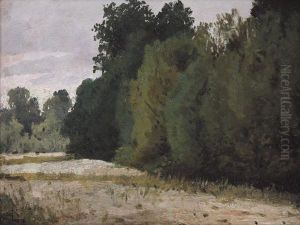Tommaso Juglaris Paintings
Tommaso Juglaris was an Italian painter, renowned for his contributions to the art world during the 19th and early 20th centuries. Born on December 18, 1844, in Moncalieri, a small town near Turin in the Piedmont region of Italy, Juglaris showed an early inclination towards the arts. His initial education in art began at the Albertina Academy in Turin, where he was influenced by the prevailing styles of his time, including Romanticism and later, aspects of Realism and Symbolism. Juglaris's work was diverse, encompassing a range of subjects from historical and religious paintings to landscapes and portraits, reflecting his versatility and adaptability to different artistic trends over his long career.
After establishing a solid foundation in Italy, Juglaris's quest for artistic growth led him to Paris, which was then considered the art capital of the world. In Paris, he was exposed to new artistic movements and techniques, which significantly influenced his style and approach to painting. He absorbed elements of the French academic style, which is evident in the classical composition and refined execution of his works. Despite the influence of European art trends, Juglaris's work retained a distinct Italian character, a testament to his roots and his pride in his heritage.
Juglaris's career was marked by significant commissions and appointments, including work for the Royal Palace of Turin and various churches and public buildings across Italy. His talent was recognized not only in his home country but also abroad, particularly in the United States, where he spent a considerable part of his later life. In America, Juglaris contributed to the burgeoning art scene through his work as a muralist, painter, and educator, leaving a lasting impact on the local artistic community. He was particularly noted for his murals, which adorned public buildings and churches, showcasing his mastery of large-scale compositions and his ability to convey narrative and emotion through his art.
Tommaso Juglaris passed away on January 31, 1925, in Moncalieri, leaving behind a rich legacy of artistic achievement. His works continue to be appreciated for their beauty, technical skill, and the unique blend of Italian tradition and international influences that characterizes his art. Juglaris's life and work remain a subject of study for art historians and a source of inspiration for artists, embodying the spirit of innovation and the pursuit of excellence that defines the best of the art world.
